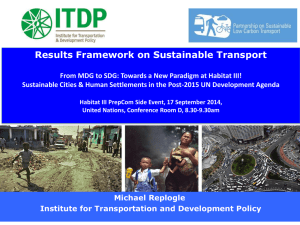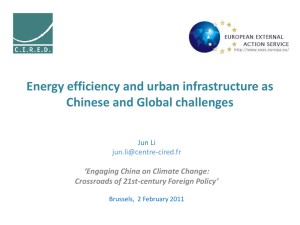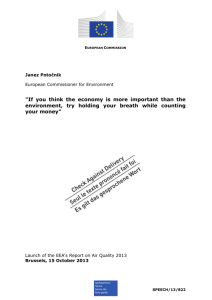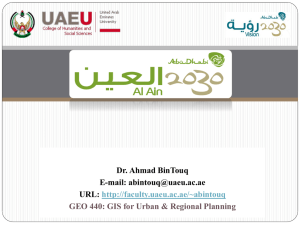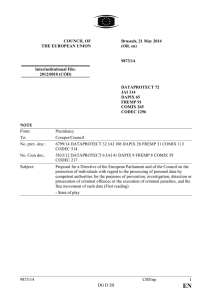I. INTRODUCTION 1. The Commission submitted the proposal on
advertisement
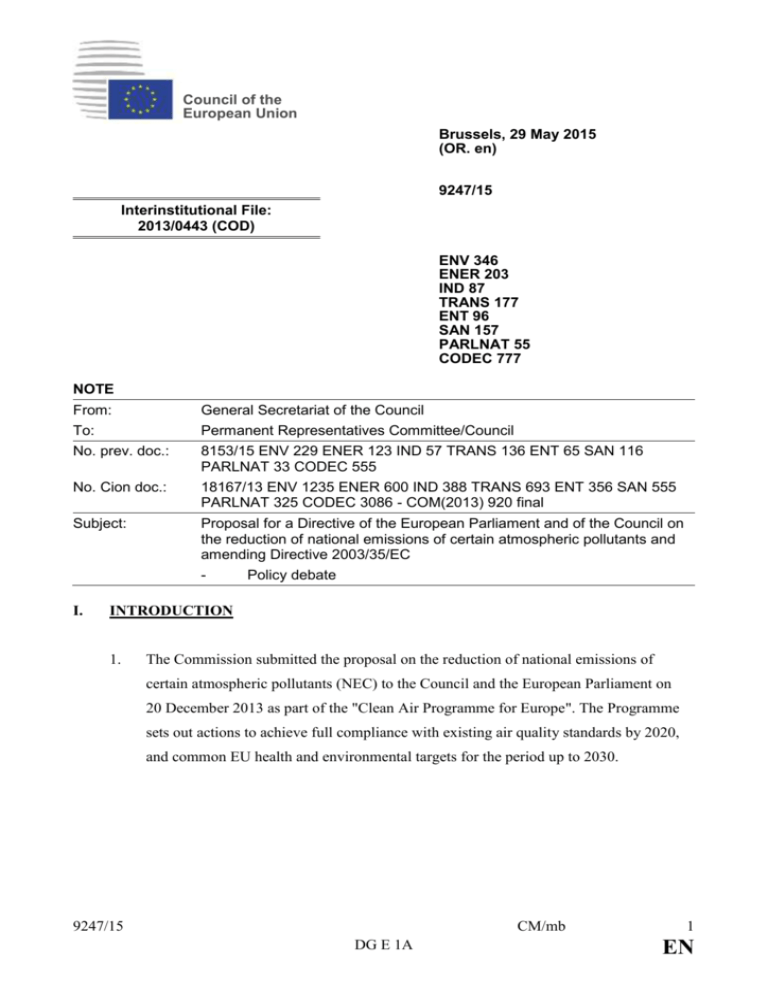
Council of the European Union Brussels, 29 May 2015 (OR. en) 9247/15 Interinstitutional File: 2013/0443 (COD) ENV 346 ENER 203 IND 87 TRANS 177 ENT 96 SAN 157 PARLNAT 55 CODEC 777 NOTE From: To: General Secretariat of the Council Permanent Representatives Committee/Council No. prev. doc.: 8153/15 ENV 229 ENER 123 IND 57 TRANS 136 ENT 65 SAN 116 PARLNAT 33 CODEC 555 18167/13 ENV 1235 ENER 600 IND 388 TRANS 693 ENT 356 SAN 555 PARLNAT 325 CODEC 3086 - COM(2013) 920 final No. Cion doc.: Subject: I. Proposal for a Directive of the European Parliament and of the Council on the reduction of national emissions of certain atmospheric pollutants and amending Directive 2003/35/EC Policy debate INTRODUCTION 1. The Commission submitted the proposal on the reduction of national emissions of certain atmospheric pollutants (NEC) to the Council and the European Parliament on 20 December 2013 as part of the "Clean Air Programme for Europe". The Programme sets out actions to achieve full compliance with existing air quality standards by 2020, and common EU health and environmental targets for the period up to 2030. 9247/15 CM/mb DG E 1A 1 EN The Commission proposal revising the NEC Directive sets requirements for the emissions responsible for particulate matter and ozone concentrations, acidification and eutrophication so as to move towards the air quality related objectives stated in the 7th Environment Action Programme (EAP) 1 "to ensure that by 2020 outdoor air quality in the Union has significantly improved, moving closer to WHO recommended levels". It repeals and replaces the current Union regime on the annual capping of national emissions of air pollutants so as to integrate the EU's international commitments for 2020 under the Gothenburg Protocol as amended in 2012. In practice, the current objectives set by Directive 2001/81/EC 2 for national emissions of sulphur dioxide (SO2), nitrogen oxides (NOx), non-methane volatile organic compounds (NMVOC) and ammonia (NH3) are maintained until 2019. New reduction commitments for all of those pollutants and for particulate matter (PM2,5) are set out for the period from 2020 and from 2030 (based on fuels sold 2005). The proposal also sets out reduction commitments for methane (CH4) for the period starting from 2030. Furthermore, the proposal defines intermediate emission levels of the same pollutants for 2025, determined on the basis of a linear reduction trajectory, unless the required measures entail disproportionate costs. 1 2 Point 54 (i) of the Annex: "implementing an updated Union air quality policy, aligned with the latest scientific knowledge, and developing and implementing measures to combat air pollution at source" OJ L 354, 28.12.2013, p 171. Directive 2001/81/EC of the European Parliament and of the Council of 23 October 2001 on national emission ceilings for certain atmospheric pollutants (OJ L 309, 27.11.2001, p.22). 9247/15 CM/mb DG E 1A 2 EN II. STATE OF PLAY 2. The Clean Air Programme, consisting of a Communication and three proposals 3 (for two Directives and a Council Decision, respectively), was presented to the Council on 3 March 2014. A policy debate on the main aspects of the two proposed Directives took place in Council on 12 June 2014. On NEC, the debate focussed on the stepwise approach to reduce pollutants (2020-2030) and on the scope of the proposal 4. 3. The Impact Assessment of the NEC proposal was presented to the Working Party on the Environment (WPE) in February 2014 and discussed in several meetings throughout the year. Bilateral meetings to discuss the country-specific scenarios, at the basis of the Impact Assessment and the proposed Directive, also took place between each Member State and Commission experts in 2014. As a result, revised scenarios for the reduction of emissions were presented to the WPE in January 2015. 4. On 19 February, 12 and 30 March, 29 April and on 28 May 2015 the WPE discussed the Commission proposal and a number of Presidency compromises 5. Several changes were introduced in the proposal by the Latvian Presidency, to address the concerns expressed both at political and technical level within Council. In particular: the emission reduction commitments from 2030 onwards 6 were updated with the values recalculated following bilateral meetings and made available in January; 3 4 5 6 Proposal for a Directive of the European Parliament and of the Council on the reduction of national emissions of certain atmospheric pollutants and amending Directive 2003/35/EC (NEC). Proposal for a Directive of the European Parliament and of the Council on the limitation of emissions of certain pollutants into the air from medium combustion plants (MCP). Proposal for a Council Decision on the acceptance of the Amendment to the 1999 Protocol to the 1979 Convention on Long-Range Transboundary Air Pollution to Abate Acidification, Eutrophication and Ground-level Ozone (Gothenburg Protocol). 10112/14. The latest Presidency compromise can be found in 8153/15. Annex II of the proposal. 9247/15 CM/mb DG E 1A 3 EN methane (CH4) was deleted from the scope of the Directive, reflecting concerns about possible overlaps with commitments related to greenhouse gas emission reduction targets; the possibility to modify and adapt the 2025 intermediate emission levels (between the 2020 and the 2030 objectives) was introduced, where this is technically or economically justified by the Member State; the flexibility regarding offset of emission reductions achieved in the maritime sector was deleted, among other reasons because it was considered complex to implement and to monitor; several deadlines in the proposal have been extended, while others are retained since the first reduction commitments (from the Gothenburg Protocol) are set in 2020. The above modifications are presently supported by a majority of delegations, while the Commission has a number of reservations (among others, on methane and flexibilities). 5. The European Parliament ENVI Committee is expected to vote on its report on 15-16 July and a vote in Plenary could take place already in September 2015. More than 500 draft amendments were recently submitted, many of them aimed at raising the level of ambition and at strengthening the proposal. III. CONCLUSION 6. To guide the policy debate on the NEC legislative proposal which will be held in Council at its meeting on 15 June 2015, the Presidency has prepared two questions preceded by a short background. 9247/15 CM/mb DG E 1A 4 EN 7. The Committee of Permanent Representatives is invited to take note of the questions prepared by the Presidency as set out in the Annex to this Note and to forward them to the Council. 8. The Presidency invites delegations to send written replies before the Council meeting and, where possible, to make joint interventions during the meeting itself. 9247/15 CM/mb DG E 1A 5 EN ANNEX I. BACKGROUND Air pollution is the most important environmental cause of death in the EU, leading to 400 000 premature deaths each year equivalent to annual external costs in excess of 900 billion euro. The NEC proposal flows from the updated air quality strategy and aims at reducing premature deaths from the current levels to ca.200 000 in 2030. The lead target of about halving the premature deaths, in the related Commission communication, was determined based on extended cost-effectiveness and sensitivity analysis. The reduction commitments from 2030 onwards are proposed by the Commission on the assumption that the 2020 commitments under the Gothenburg Protocol can be achieved by fully implementing the existing air quality legislation. The additional 2030 reduction commitments would reduce total external costs of air pollution by a further 45 billion euro (on the most conservative valuation) or ten times the compliance cost. Direct economic benefits are linked to reduced labour productivity losses, reduced health care costs, reduced crop losses and reduced damage to the built environment. During the debate in Council in June 2014, many delegations supported the step-by-step approach and the coverage of all economic sectors, but concerns were expressed on the level of ambition, particularly as regards the ceilings to be reached by 2030. Several delegations said that further examination of the impacts of the proposed emission ceilings should be carried out, especially impacts on the agricultural sector. The Commission showed openness to do so, and encouraged delegations to preserve the high level of ambition of the proposal also recalling the air quality objectives of the 7th EAP. 9247/15 ANNEX CM/mb DG E 1A 6 EN Following that debate and bilateral meetings with the Member States, the Commission updated its analysis to reflect the issues raised and Member States' recent revisions of the 2005 base year emissions. To achieve the same level of ambition, the analysis provided, for each Member State, the updated emission reduction commitments applicable from 2030 for each pollutant and indicated that the overall annual compliance costs would be reduced by one billion euro. While these figures were generally positively received, several Member States asked some additional time to complete their domestic analysis of the achievability of the 2030 targets. Other Member States expressed concern on how achievability could be affected if future economic developments differed from those assumed in the Commission's analysis. II. QUESTIONS Against this background, the Presidency has prepared the following questions for the debate: 1. Building on the results of the Council' s debate in June 2014 where a stepwise approach towards the 2030 horizon, with the contribution of all sectors, was supported, what are the main difficulties in attaining the 2030 horizon as updated? 2. With a view to the lead target to reduce by 50% the number of premature deaths in the EU, what additional elements, if any, could be explored in order to elaborate solutions for the 2030 horizon which are both realistic and ambitious? 9247/15 ANNEX CM/mb DG E 1A 7 EN

